Pedro Llosas Badía
Pedro Llosas y Badía (Catalan: Pere Llosas i Badia) (1870–1955)[1] was a Spanish right-wing politician. Active in Catalonia, he was first associated with the Carlists and then with the Primo de Rivera regime. He was the longest-serving Carlist deputy from Catalonia during the Restauración[2] but is known mostly as the civil governor of La Coruña and Baleares provinces during the dictatorship.
Pedro Llosas Badía | |
|---|---|
 | |
| Born | Pedro Llosas Badía 1870 |
| Died | 1955 Olot |
| Nationality | Spanish |
| Occupation | banker |
| Known for | politician |
| Political party | Carlism, UP |
Family and youth
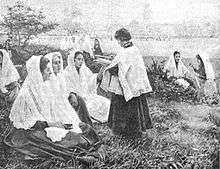
The Llosas family has traditionally been active in the Catalan textile industry as cotton weavers; in the 19th century they established themselves in middle-low range of the local bourgeoisie.[3] Paternal grandfather of Pedro, Juan Llosas Pujol, originated from Olot (Girona province), located in the comarca of Alt Garrotxa at the Pyrenean foothills.[4] His son and Pedro's father, Juan Llosas Tenas (died 1872), in early years left his native region for Albacete, for over 20 years assisting his uncle in running a textile business.[5] When the shop was inherited by his cousin, Albert Escubós Llosas, he returned to Olot and married Rosa Badía Trull (died 1896),[6] a native of Sallent (Barcelona province).[7] The couple possessed land properties in the neighboring Santa Pau and Mieres.[8] Pedro was the only child of the couple.[9]
Except that he was very early orphaned by his father, next to nothing is known about Pedro's early childhood in Olot, a town that became a headquarters of Carlism during the Third Carlist War. In 1882 he entered the nearby Seminario-Colegio de Santa María del Collell, originally an ecclesiastic seminary in 1876 merged with Instituto de Segunda Enseñanza de Girona; the establishment allowed pursuing religious path but offered also commercial studies.[10] In 1887 he obtained bachillerato, officially issued by Instituto de Girona,[11] and enrolled at Facultad de Filosofía y Letras in the University of Barcelona. Llosas graduated in 1890, his dissertation dedicated to the Gracchus land reforms in the ancient Rome and acknowledged with excellent marks.[12] He pursued scientific path later on, already when he served as deputy in Madrid; in 1915 he graduated in Madrid in history,[13] his thesis titled Renaixement de Catalunya, època del rei Martí l'Humà;[14] also later he remained particularly interested in archeology.[15] One source refers to him as „abogado”.[16]
Having returned to Olot in 1893 Llosas Badía married Anna Serat-Calvó y Plana (died 1942);[17] they settled at calle de San Jerónimo 47.[18] In 1895 he and two relatives founded a local bank, Banco Llosas, Escubós y Puigmitjà,[19] which proved successful and remained their property until the mid-1920s.[20] Pedro and Anna had 6 children, born between 1894 and 1904, but the family life was marked by recurring tragedies: María died in early infancy, Rosa - who married Joaquin Vayreda Aulet, son the Olot Traditionalist painter and author, Marian Vayreda[21] - died at 23 in 1918,[22] Nonito died also at 23 in 1921[23] and Juan died at 41 in 1933.[24] Of the two surviving, Martirián Llosas y Serrat-Calvó - also a Carlist[25] - was active in the Barcelona juvenile court, during early Francoism serving briefly as president of the Gerona diputacion[26] and rising to president judge of Tribunal Tutelar de Menores de Barcelona and president of Union Nacional de Tribunales Tutelares de Menores,[27] apart from having been president of Obra Tutelar Agraria for 27 years.[28] Miguel Llosas y Serrat-Calvó pursued a law career[29] and was also active as judge for the minors,[30] but became a public figure mostly as a man of letters.[31] Apart from lesser works on history[32] and culture;[33] his major study focusing on ancient Rome, Berenice, was published posthumously.[34]
Carlist
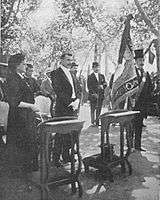
In the late 19th century Olot was among Catalan Carlist strongholds. Painting activity of Escuela de Olot and literary works of Marian Vayreda y Vila made it cultural centre of regional Traditionalism and conservative Catalanism.[35] The young Pedro – though nothing is known about political preferences of his ancestors – was growing exposed to both and actively engaged in both.[36] In 1891 he was already reported as secretary of the local Centre Catalanista,[37] 1892 growing to its vice-president;[38] during his early years he also entered the local Circulo Tradicionalista,[39] at unspecified date rising to its president.[40] In the mid-1890s Llosas was also busy in local Olotense and regional Catalan Catholic initiatives.[41] Apart from organizational work he was active as a speaker[42] and especially as an author, contributing to periodicals like L’Olotí and El Deber, though also Diario de Olot[43] and El Ateneo;[44] his writings revealed a knack for culture and history.[45] Known locally, until the early 20th century Llosas did not emerge as a recognized figure in Catalan Carlism.[46]
In 1897 Llosas was elected to the Olot ayuntamiento,[47] becoming the third teniente de alcalde,[48] president of Comisión de Gobernación and member of the other two.[49] During the following term[50] he grew to the first teniente de alcalde, president of Comisión de Fomento and vocal of the central, hospital[51] and economy[52] commissions, in 1900 briefly serving as alcalde.[53] In 1903 Llosas presented his candidature to the provincial self-government of Girona; he stood as a "regionalista".[54] Elected from the Olot-Puigcerda district, he served as diputado until 1907.[55] In the provincial self-government he represented a Traditionalist version of regionalism, declaring himself a Catalanist and anti-centralist;[56] his opening address in the chamber was in Catalan, an extravaganza which earned him admonition by the president.[57] As member of diputación he inspired and supported a new Olot Traditionalist periodical, La Tradició Catalana.[58] At that time he also published pamphlets formatted as discourses on political philosophy.[59]

In mid-1900s Llosas decided to run for the Cortes. The Olot district voted Carlists in the late 19th century,[60] but in the 1899-1907 it was conquered by La Lliga.[61] The two competing groupings joined ranks in 1907, together with the Republicans forming Solidaritat Catalana.[62] Though some solidaris accepted Llosas with difficulty,[63] the strategy paid off; he was among seven Carlists voted in from Catalonia.[64] The alliance soon disintegrated, but also in the following years La Lliga and the Carlists avoided fielding candidates in the same districts; as Olot was left to the Carlists,[65] Llosas retained his mandate in successive campaigns of 1910,[66] 1914[67] (when he ran as independent)[68] and 1916 (declared victorious with no challenger),[69] having been member of a small, depending upon term 6 to 14-member Carlist minority. His parliamentarian activity – vibrant especially during earlier terms[70] - was marked mostly by defense of Catholic Church[71] and by his modest Catalanism,[72] culminating in confronting the government sponsored Ley del Candado.[73] He was counted among representatives of Catalan "carlisme nou";[74] in 1912 he entered the Carlist national executive.[75]
Bewildered

In the late 1910s the Catalan Carlism was undergoing rapid fragmentation, marked by at least three not necessarily overlapping division lines: between supporters of the key party theorist Vázquez de Mella versus supporters of the claimant, between those approaching nascent Catalanism with sympathy versus those viewing it with caution, and between a faction favoring wide conservative alliances versus a faction sticking to stand-alone intransigence.[76] Though a 1912 Carlist propaganda publication hailed his „acrisolada lealtad a los ideales Católico-Monárquicos”,[77] Llosas was not immune to growing confusion.
In Girona the key division line was about the Catalan question.[78] Llosas, unlike other key Carlist from the province Dalmacio Iglesias, tended to demonstrate more attraction for Catalanism than the official party executive would allow. In 1917 he took part in Parliamentary Assembly, a gathering of some 70 senators and deputies mostly from Catalonia.[79] Called in the wake of growing social tension, the congregation declared the Restoration political system defunct and assumed a potentially revolutionary shape, pursuing also a highly regionalist model of state.[80] Since the Carlists decided to abstain, Llosas joined the initiative on his own; some authors claim that he broke with the party,[81] but others underline that proposals of the Assembly were later supported by the Carlists.[82]
The 1918 electoral campaign produced total bewilderment. Despite Llosas’ taking part in the pro-Catalanist Assembly, La Lliga terminated the truce with the Carlists and fielded his counter-candidate in Olot. The Carlists themselves were divided into 3 factions led by Junyent, Iglesias and Llosas, the latter turned against La Lliga running as an ultra-Right anti-regionalist hopeful.[83] Despite his differences with party executive, he was widely referred to as "carlí", "jaumí"[84] or "tradicionalista".[85] By a narrow margin he seemed to have lost to his Lliguero rival.[86] He protested, pressing charges of corruption; investigations and backstage haggling continued until he was finally declared defeated.[87]
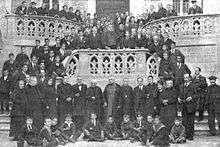
When the internal Carlist conflict between de Mella and Don Jaime exploded in 1919 Llosas seemed posed to join the rebels. In the Cortes under the influence of the former[88] and sharing his penchant for grand conservative alliances,[89] initially he tended to stand against the claimant.[90] Eventually he declared himself neutral;[91] indeed, after the breakup he was listed neither among the breakaway Mellistas[92] nor the loyal Jaimistas. Instead, he neared the right wing of disintegrating Conservatives, the Mauristas;[93] in the 1919 electoral campaign he unsuccessfully ran for the Senate as a governmental candidate,[94] defeated for the upper chamber also in 1921 with only 16% of the votes gathered;[95] some kept referring to him as "jaimista".[96]
Llosas's affair with the Mauristas continued; in October 1921 Maura, prime minister at that time, appointed him civil governor of the Balearic Islands. Little is known about his tenure; according to present-day scholar, he demonstrated rather heavy hand and acted along "lógica dins un sistema caciquista basat en la venjanca",[97] having been firm element of the caciquismo structure.[98] For reasons which are not clear he resigned from the governor post in April 1922 and returned to Olot.[99]
Primoderiverista
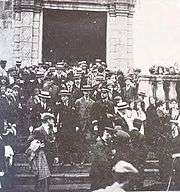
Llosas welcomed the 1923 coup of general Primo de Rivera and already in 1924 he was busy setting up provincial structures of nascent Unión Patriótica; he emerged heading the Olot branch,[100] though he did not enter the provincial Girona executive.[101] Also 1924 he was nominated to two Catalan self-government bodies, provincial and regional ones, normally elected but its members appointed under the new dictatorial regime. One was Diputación Provincial of Girona,[102] whose members elected him president of the body.[103] Another was Permanent Council of Mancomunitat de Catalunya;[104] he briefly served as Conseller de Ferrocarrils i Obres Hidràuliques and member of Consell de Pedagogia, before becoming member of Consell de Cultura.[105] At the latter post he shielded Institut d'Estudis Catalans from growing españolismo,[106] advocated introduction of Catalan to schools[107] and developed local libraries.[108]
In 1924 the Girona diputación addressed Primo with a Llosas-inspired document, which opposed centralization designs of Catalan capitán general Barrera[109] and advanced a highly regionalist vision of state in general and Catalonia in particular.[110] The paper proposed a province-centred organization of Catalonia modeled on the Vascongadas.[111] It suggested that on the regional level Mancomunitat, itself deemed artificial, is replaced by a new body, Diputación Regional, its members delegated from provincial chambers, themselves elected on universal, corporative and municipal basis.[112] However, the new primoderiverista Estatuto Provincial potentially led to dissolution of regional bodies;[113] anxious to retain some regional co-ordination,[114] Llosas failed to convince other members of the Girona diputation,[115] who effectively buried the idea of Mancomunitat.[116] Acknowledging defeat Llosas resigned as head of Girona self-government.[117] Nevertheless, he took part in works of Comissió Gestora entrusted with phasing out Mancomunitat until the body ceased to exist in 1925.[118]
Despite differences with the military, Llosas by no means could have been considered in opposition to Primo;[119] his stance during tenure in Diputación Provincial and Mancomunitat should rather be viewed as efforts to find a compromise within framework of the regime. On good terms with the dictator, in May 1925 he was appointed civil governor of La Coruña province.[120] Apart from standard administrative activities[121] he again pursued a heavy-handed political line;[122] aligned with the government, he cared little about the local opinion,[123] though some refer to him as a pragmatist.[124] Quoting health reasons and issuing an ambiguous farewell statement,[125] he resigned in April 1926.[126] The same year he was transferred to the parallel post in the Balearic Islands, commencing a second string in Palma.[127] Little is known about his tenure. Press of the era provided only official information about cultural activities,[128] diplomatic routine,[129] construction of public utility establishments,[130] propaganda,[131] building new railway lines[132] etc., though there were single complaints about his uncompromising stand recorded.[133] Upon resignation of Primo in 1930 Llosas put himself at disposal of the new Berenguer government and was not re-appointed.[134] He settled back in Olot,[135] dedicating himself to family[136] and business.[137]
Retiree: Republic and Francoism
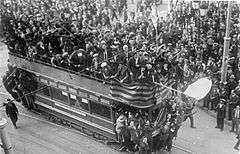
Llosas enjoyed excellent financial standing; apart from family properties, he held managerial posts in the Olot branch of Banco Hispano Americano,[138] the giant which took over Banco Llosas Escubós in the mid-1920s;[139] he was referred to as "banquer",[140] "propietario",[141] "comerciante" and "haciendista".[142] He basked in prestige of key Girona politician,[143] a charismatic figure[144] and local patricio, his house continuously visited by applicants seeking support.[145] Llosas’ position changed dramatically upon advent of the Republic: as a former dictatorship tycoon, a monarchist and a Traditionalist reactionary he found himself politically sidetracked. A street in Santa Pau, named after him in 1930,[146] was immediately renamed to Via de la República in 1931.[147]
Llosas focused on religious activity: in the early 1930s he took part in Catholic initiatives like Pro Ecclesia et Patria weeks, contributed to confessional periodicals[148] and in 1933 led a large group of Catalans visiting Vatican.[149] He resumed contacts with Carlism.[150] During run-up to the 1933 electoral campaign he was initially reported as standing in candidatura de derecha agraría, neighboring with frontline Carlist activists like Urraca Pastor and defined as "tradicionalista";[151] eventually he declared the news not authorized.[152] He kept supplying historical and religious articles to Traditionalist periodicals.[153] In early 1936 Llosas together with other Catalan Carlists[154] took part in broad monarchist gatherings led by Calvo Sotelo,[155] though his relations with Carlism remained loose.[156]
Llosas welcomed the coup of July 1936 though there is no information on him having been involved.[157] Following the outbreak of hostilities Olot was overtaken by Republican militias, who raided estates belonging to individuals deemed sympathetic towards the Right; according to one version the Llosas’ Mas Quintana mansion in Santa Pau was ransacked, with all movable items robbed and the immovable ones[158] destroyed;[159] according to another, it was expropriated in an orderly manner.[160] Though his age did not save from execution,[161] he survived the outburst of revolutionary zeal. None of the sources consulted provides information on his whereabouts during the Civil War. Immediately following Nationalist seizure of Catalonia, in February 1939 Llosas rushed to offer his services to the new Presidente de la Diputación,[162] March 1939 entrusted with gathering trade and industry managers of Girona province to proceed with the post-war reconstruction.[163] However, apart from the very early months of Francoism in Catalonia he was no longer reported as engaged in any official activities.
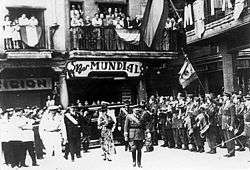
There is almost no information on Llosas’ public activity in the 1940s and later.[164] Its key thread was engagement in numerous religious initiatives,[165] reported as late as the early 1950s.[166] Another was culture; apart from sporadic public appearances[167] he was supplying historical pieces, usually related to religious topics, to the press, mostly to the Girona edition of ¡Arriba España!;[168] the periodical referred to him as "respectable y querido amigo".[169] In 1947 he became a great-grandfather,[170] but since 1949 he remained seriously disabled.[171] His funeral was attended by president of Diputación Provincial, alcalde of Olot, leaders of provincial Movimiento and representatives of Carlism.[172] His obituary in ¡Arriba España! claimed he had always been a Traditionalist.[173]
See also
Footnotes
- some sources claim he was born 1872, see the official Cortes service, available here, though most maintain the correct birth date is 1870, see Núria Moret i Llosas, El llegat documental de Pere Llosas i Badia, [in:] Annals del Patronat d'Estudis Històrics d'Olot i Comarca 1994, p. 54, Biblioteca de Catalunya service, available here, Lluís Costa Fernández, La dictadura de Primo de Rivera a Girona: premsa i societat (1923-1930) [PhD thesis Universitat de Girona], Girona 1994, ISBN 9788469427996, p. 188, B. de Artagan [Reynaldo Brea], Políticos del carlismo, Barcelona 1912, p. 236, Isidre Molas, Els senadors carlins de Catalunya (1901-1923), Barcelona 2009, p. 14 or obituary in ¡Arriba España! 03.12.55, available here; also FamilySearch, "España, bautismos, 1502-1940," database, available here
- Narciso Battle Baro and Josep Suelves Montagut were other Catalan Carlists serving 4 turns in the Cortes, but in terms of monthly duration Llosas' tenure lasted longer
- Moret i Llosas 1994, p. 54
- Moret i Llosas 1994, p. 53
- Moret i Llosas 1994, p. 54
- Eco de la montaña 31.05.96, available here, L’Olotí 31.05.96, available here
- Moret i Llosas 1994, p. 54
- Moret i Llosas 1994, p. 55
- Rosa Badia's certificate of death, available here
- Bulleti del Santuari S. María del Collel 7 (1917), available here
- Moret i Llosas 1994, pp. 54-5
- Moret i Llosas 1994, p. 54
- some scholars suspect he might have intended to obtain PhD laurels, Moret i Llosas 1994, p. 54
- El Deber 04.12.15, referred after ¡Arriba España! 04.12.65, available here
- „aficionat a l’arqueologia”, Josep Burch i Rius et al. (eds.), Emili Gandia i la conservació del patrimoni cultural a la Catalunya de començament del segle XX, Girona 2015, ISBN 9788499843018, page unavailable, accessible here
- Artagan 1912, p. 236; no information on his would-have-been law studies is available elsewhere
- Moret i Llosas 1994, p. 54, La Vanguardia 14.03.42, available here; also FamilySearch, "España, matrimonios, 1565-1950," database, available here
- Guía Oficial de España 1911, p. 61, available here; later they moved to calle Fontanella, ¡Arriba España! 03.12.55, available here; the couple also possessed an estate in neighboring Santa Pau, Tradició Catalana 12.08.33, available here
- Moret i Llosas 1994, p. 55
- the bank served both local aristocrats like marqués de Monistrol and local companies, like Sangrà i Cia, Moret i Llosas 1994, p. 55; apart from the local provincial market it was also engaged in some nationwide schemes like hydrotechnical works on the Guadalquivir, see ABC 06.06.15, available here, and was first one in Girona province to introduce safe deposits, Ramón Llongarriu i Monsalvatje, La banca a Olot, [in:] bohigas service, available here
- the wedding took place in 1917, Comarca 12.05.17, available here, see also La Vanguardia 03.01.69, available here; Rosa Llosas probably died when giving birth a year later, La Comarca 01.06.18, available here
- El Deber 01.06.18, available here
- Tradició Catalana 22.07.22, available here
- La Vanguardia 16.02.33, available here
- in the late 1940s and the early 1950s he was member of Junta Regional, the Catalan Carlist executive, César Alcalá, D. Mauricio de Sivatte. Una biografía política (1901-1980), Barcelona 2001, ISBN 8493109797, pp. 95, 99
- La Vanguardia 16.08.39, available here
- La Vanguardia 14.06.69, available here
- La Vanguardia 22.10.85, available here
- La Vanguardia 09.12.28, available here
- Santiago Olives Canals, Stephen Taylor, Who's who in Spain vol. 1, Madrid 1963, p. 508
- compare his works at Biblioteca de Catalunya service, available here
- e.g. Besalú al setge d'Almenara, [in:] Assemblees d'estudis Besalú 1 (1968), pp. 91-98 or El comte Tallaferro a Còrdova, [in:] Assemblees d'estudis Besalú 2 (1973), pp. 183-200
- e.g. El arte moderno en su proyección religiosa, [in:] Cristianidad 17 (1960), pp. 26-29
- Miguel Llosas y Serrat-Calvó, Berenice, Girona 2007, ISBN 9788496766075
- there is massive literature on Vayreda, covering his paintings, his literary works, his political activity and his ideology; on the latter, see e.g. Rafael Botella García-Lastra, El carlismo en la novela, [in:] Miguel Ayuso (ed.), A los 175 años del carlismo, Madrid, 2011, ISBN 978-8493678777, pp. 401–434 Narcís Selles, Entre un món residual i un món emergent, [in:] Esposició antologica de Marian Vayreda i Vila (1853 - 1903), Olot 2003, pp. 25–31, Narcís Selles, Marian Vayreda: idealització i conflicte davant d'una realitat canviant, [in:] Revista de Girona 220 (2003), pp. 30–35, Edgar Illas, Marià Vayreda. El carlisme reciclat i l'inconscient català, [in:] El contemporani: revista d'història 27 (2003), pp. 48–51, Francesc Roma, Del Paradís a la Nació: la muntanya a Catalunya, segles XV-XX, Valls 2004, ISBN 8497910818 and works of Jordi Canal, quoted later
- on complex relationship between Carlism and Catalanism see detailed discussion in Jordi Canal, Carlisme i catalanisme a la fi del segle XIX. Notes sobre unes relacions complexes, [in:] Le discours sur la nation en Catalogne aux XIXe et XXe siècles. Hommage à Antoni M. Badia i Margarit, Paris 1995, pp. 211–230, Jordi Canal, ¿En busca del precedente perdido? Tríptico sobre las complejas relaciones entre carlismo y catalanismo a fines del siglo XIX, [in:] Historia y Politica 14 (2005), pp. 45-84, Jordi Canal, Marian Vayreda, entre el carlisme i el catalánisme, [in:] Revista de Girona 225 (2004), pp. 41–46
- L’Oloti 09.08.91, available here
- L’Oloti 10.01.92, available here
- Moret i Llosas 1994, pp. 54-5
- Artagan 1912, p. 236
- Eco de la montaña 12.08.94, available here
- Artagan 1912, p. 236
- Moret i Llosas 1994, p. 55
- Revista del Ateneo Obrero de Olot, 01.03.08, available here
- Album literati y artístich de l’Oloti 1 (1894), available here
- Llosas is not listed a single time in a monographic work on Catalan Carlism of the late 19th century, see Jordi Canal, El carlisme català dins l’Espanya de la Restauració. Un assaig de modernizació política (1888-1900), Vic 1998, ISBN 8476022433
- Artagan 1912, p. 236, also Deber 15.05.97, available here
- Annuario-Riera 1899, p. 931, available here
- Comisión Central and Comisión de Hospital, Moret i Llosas 1994, p. 56
- which commenced in 1899
- Moret i Llosas 1994, p. 56
- Annuario-Riera 1904, p. 1604, available here
- following health problems of the mayor himself, Sanch Nova 30.12.00, available here
- Montanyench 15.03.03, available here
- Moret i Llosas 1994, p. 56; he was one of 14 deputies to Girona provincial self-government and one of 51 deputies in all 4 Catalan provinces between 1900 and 1923, Molas 2009, pp. 22-3
- La Información 22.09.04
- i. e. José Puig y Corominola, Costa Fernández 1994, p. 286
- Costa Fernández 1994, p. 416
- Veritable concepte de la democràcia cristiana (1902), Concepte filosòfich-social de la tradicìò: discurs llegit per son autor en la solemne sessió literària-musical celebrada baix la presidencia del Exm. Sr. Bisbe de Vich, Dr. Joseph Torras y Bages (1903)
- in 1896 and 1898 Olot elected a former Carlist military, Joaquín Llorens, see the official Cortes service, available here
- Albert Balcells, Joan B. Culla, Conxita Mir, Les eleccions generals a Catalunya de 1901 a 1923, Barcelona 1982, p. 430
- the alliance was united mostly by opposition to the so-called Ley de Jurisdicciones; for detailed discussion, see Maria Gemma Rubí i Casals, Francesc Espinet, Solidaritat catalana i Espanya (1905-1909), Barcelona 2008, ISBN 9788492437153
- Balcells, Culla, Mir 1982, p. 127
- he obtained 54,79% of the votes and his independent counter-candidate 44,39% (abstention 24,66%), Balcells, Culla, Mir 1982, p.523; see also the official Cortes service, available here
- Balcells, Culla, Mir 1982, pp. 204, 221, 227
- he obtained 85,93% of the votes and his mearest counter-candidate, a republican radical, 11,97% (abstention 24,63%), Balcells, Culla, Mir 1982, p.534, see also the official Cortes service, available here
- he obtained 80,83% of the votes and his mearest counter-candidate, a republican , 15,14% (abstention 27,53%), Balcells, Culla, Mir 1982, p.547, see also the official Cortes service, available here
- Balcells, Culla, Mir 1982, p. 198; his victory was overwhelming and the scale of opposition posed by his republican opponent is named „symbolic”, Balcells, Culla, Mir 1982, p. 204
- Balcells, Culla, Mir 1982, p. 227, see also the official Cortes service, available here
- e.g. in 1907 he spoke 20 times, Artagan 1912, p. 236
- in recognition of his merits, in 1914 he was awarded Pro Ecclesia et Pontífice, a papal medal conferred upon those distinguished in their service to the Church, Moret i Llosas 1994, pp. 58-9
- Moret i Llosas 1994, pp. 56-7
- compare El Kulturkamf Español. Primera Etapa. La Ley llamada del Candado y la oposición católica en las Cortes. Colección de discursos pronunciados por los Reverendos Prelados y por los representantes de las Minorías tradicionalistas, Madrid 1915
- with Junyent, Argemí, Trías and Iglesias, i.e. militants who did not remember the Third Carlist War and grew during Restoration, Molas 2009, p. 14
- named Junta Superior Central; all Carlist parliamentarians entered the body by default; within the body Llosas was appointed to Comisión de Acción Social in 1913, see Melchor Ferrer, Breve historia del legitimismo español, Madrid 1958, p. 97, Agustín Fernández Escudero, El marqués de Cerralbo (1845-1922): biografía politica [PhD thesis UNED], Madrid 2012, pp. 445, 458
- other division lines were between Carlists who viewed their movement as „party of order” versus young urban militants with penchant for violence, see Colin M. Winston, Workers and the Right in Spain, 1900-1936, Princeton 2014, ISBN 9781400858095, p. 85, and differences over personal issues, e.g. in case of Llerida province, see Conxita Mir, Lleida (1890-1936): caciquisme polític i lluita electoral, Barcelona 1985, ISBN 9788472027169, pp. 308-310
- Artagan 1912, p. 237
- some areas of the Olot district adopted "un posicionament proper al regionalisme i encetaren un acostament a la Lliga", while in the Girona generally the mood was rather against the Catalanists, Costa Fernández 1994, pp. 32-3
- El Pais 08.07.17, available here
- Llosas and others were "baluarte monarquico ante las amenazas militares y civiles"; some sources claimed that Llosas himself co-drafted an autonomy proposal, later supported by the regionalists and others, Maximiliano Fuentes Codera, España en la Primera Guerra Mundial: Una movilización cultural, Madrid 2014, ISBN 9788446040262, page unavailable, accessible here
- Moret i Llosas 1994, p. 57
- other authors claim the autonomist proposals of the assembly were supported by the Jaimists, see Fuentes Codera 2014
- Junyent concluded alliances with La Lliga and the Maurists, while Llosas, Iglesias and Trias were presenting themselves as ultra-Right anti-regionalists candidates, supported by the anti-regionalist El Norte, Xavier Tornafoch, Política, eleccions i caciquisme a Vic [PhD thesis Universitat Autonoma de Barcelona], Barcelona 2003, p. 199, also Costa Fernández 1994 p. 34, Balcells, Culla, Mir 1982, pp. 249, 256, 263
- Balcells, Culla, Mir 1982, pp. 256, 571, also ABC 25.02.18, available here, El Sol 12.02.18, available here
- Albert Balcells, Enric Pujol, Jordi Sabater, La Mancomunitat de Catalunya i L'Autonomia, Barcelona 1996, ISBN 9788472833296 p. 247
- having gained 45,37% of the votes; his victorious counter-candidate, a Lliguero candidate, obtained 53,97% of the votes (abstention 16,99%), Balcells, Culla, Mir 1982, p.571. In the early campaigns, when in open accord with La Lliga, Llosas enjoyed absolute majority among the electorate, but over time his domination decreased. In 1907 he was supported by 75% of those eligible to vote, in 1910 by 65%, in 1914 by 37%. For 1916 - as he had no counter-candidate - no number-crunching is possible. In 1918 he was supported by 38% of the electorate, but his Lliguero rival attracted 45% of those eligible, data Balcells, Culla, Mir 1982
- Moret i Llosas 1994, p. 57
- in 1912 formed part of grupo parlamentario africanista, co-led by Vázquez de Mella. El Siglo Futuro 24.12.12, available here
- Molas 2009, p. 9
- in Catalonia Carlism fragmented into 3 groupings: firstly the majoritarian one headed by Junyent, Trias and Roma, organized around Correo Catalan, pro-League and loyal to Don Jaime; secondly the minoritarian one led by Pedro Vives and centred around Ateneu Tradicionalista and thirdly another one, led by Dalmacio Iglesias and dominating in Girona province, the latter ones sided with the Mellistas, Balcells, Culla, Mir 1982, p. 285
- Molas 2009, p. 10; the provincial Girona jefatura of the Mellistas went to Joaquim de Solà Morales
- Llosas is not a single time mentioned in scholarly monograph on the Mellista movement, see Juan Ramón de Andrés Martín, El cisma mellista. Historia de una ambición política, Madrid 2000, ISBN 9788487863820
- Molas 2009, p. 10
- El Siglo Futuro 07.06.19, available here, El Pais 14.06.19, available here
- Moret i Llosas 1994, p. 57
- El Sol 14.06.19, available here
- Isabel Peñarrubia i Marquès, Els partits polítics davant el caciquisme i la qüestió nacional a Mallorca (1917-1923), Barcelona 1991, ISBN 9788478262724, p. 109
- Peñarrubia i Marquès 1991, p. 59
- Moret i Llosas 1994, p. 57
- Costa Fernández 1994, p. 210
- Costa Fernández 1994, p. 208
- Costa Fernández 1994, pp. 185-6
- with 18 votes in favor and 1 abstaining, Moret i Llosas 1994, p. 57
- Costa Fernández 1994, p. 189
- Moret i Llosas 1994, p. 57
- viewed with sincere hostility by the government, Costa Fernández 1994, p. 285. Llosas vehemently opposed attempts to merge the Institute with the University, Costa Fernández 1994, p. 287-8; he also helped to develop new activities of the Institute, like library, meteorological, historic-archeologic and especially philology services, establishing as a newly created section, „Servicio de Investigaciones Filológicas” - Costa Fernández 1994, pp. 286-9
- Costa Fernández 1994, pp. 285-6
- La Vanguardia 24.10.24, available here
- other author claims that Llosas was not in favor of abolishing Mancomunitat, Costa Fernández 1994, p. 196
- "posicionament regionalista de Llosas", Costa Fernández 1994, p. 191
- "amb una actitud propera a la manifestada antigament per carlins i jaumins, que propagaven una solució semblant a les diputacions basques, és a dir, implantar el régim provincial de les provincies bascongades", Costa Fernández 1994, p. 196; opposing centralist views were sponsored presided by general Barrera and Frederic Bassols
- Costa Fernández 1994, pp. 191-2
- the new Provincial Stature it did not necessarily mean dissolving Mancomunitat, Costa Fernández 1994, p. 197
- Costa Fernández 1994, pp. 198-9; Llosas was anxious that lack of regional coordination would produce a downturn in some areas, especially public works, Costa Fernández 1994, p. 197
- bowing to the pressure of provincial civil governor Urquía
- Costa Fernández 1994, p. 11
- some refer to the event as „fi de la carrera política de Llosas a Girona”. Costa Fernández 1994, p. 197
- Moret i Llosas 1994, p. 58
- „vinculat al poder de Madrid”, Jordi Pujiula, Dictadura, República i Guerra Civil, Olot 2005, ISBN 9788493262457, pp. 13
- El Imparcial 21.05.25, available here
- see La Nación 09.02.26, available here
- e.g. banning a conference declared as scientific but suspected of pursuing a hidden political agenda, Costa Fernández 1994, p. 197
- Costa Fernández 1994, p. 289
- Costa Fernández 1994, p. 290
- "declara sinceramente que, identificado con el generoso sentir y las costumbres de Galicia, no le ha sido difícil fundar sus normas de gobierno "en una base de realidad eterminada por múltiples semejanzas y analogías y en la adopción de medidas de leal advertencia y suave persuasión antes dc recurrir a procedimientos coercitivos, ingratos de suyo, aunque saludables y necesarios en ciertos casos", La Nación 03.05.26, available here.
- Moret i Llosas 1994, p. 58
- Heraldo de Madrid 28.04.26, available here
- e.g. setting up Museo Pedagógico Provincional, La Nación 25.12.28, available here
- he received the Italian Ordine dei Santi Maurizio e Lazzaro, bestowed upon him by Mussolini in 1929; the honor seemed fairly routine, result of Italian military aircraft squadron landing at the Baleares during a courtesy visit, Moret i Llosas 1994, p. 59
- La Vanguardia 26.07.28, available here, La Vanguardia 14.09.27, available here
- La Vanguardia 10.07.28, available here
- La Vanguardia 10.07.29, available herel
- Jaume Pomar, La raó i el meu dret: biografia de Llorenç Villalonga, Palma de Mallorca 1995, ISBN 9788427340381, p. 123
- Moret i Llosas 1994, p. 58
- La Vanguardia 21.02.30, available here
- his oldest son died in 1933 in his early 40s, La Vanguardia 10.02.33, available here
- his private archive contains politically relevant documents dated prior to 1930 only, Moret i Llosas 1994, p. 61
- Moret i Llosas 1994, p. 55. In the 1920s the Spanish financial market was subject to consolidation, with 5 major banks dominating the industry - Banco Hispano Americano, Banco Español de Credito, Banco Central, Banco de Bilbao and Banco de Vizcaya, Moisés Llordén Miñambres, Manuel-Jesús González, De empresas y empresarios en la España contemporanea, Oviedo 1995, ISBN 9788474688191, p. 96. One of the most aggressive players, Banco Hispano Americano, pursued a growth strategy consisting of taking over smalle banks and convering them into own branches – from 6 (1914) to 20 (1919), 50 (1923) and 87 (1926) Llordén, González 1995, p. 96
- BHE entered merger talks with Banco Llosas Escubós in 1920 Moret i Llosas 1994, p. 55, also El Financiero 20.08.20, available here, completing the process in 1923, Muñoz García Muñoz, El Fracaso de la Burguesía Financiera Catalana: La Crisis Del Banco de Barcelona, Barcelona 1988, ISBN 9788477310099, p. 308; Llosas grew also to vice-president of Asociación de Banqueros de Barcelona - Moret i Llosas 1994, p. 56
- Molas 2009, p. 19, Balcells, Culla, Mir 1982, p. 430, also "ex-banquer", Costa Fernández 1994, pp. 185-6
- Molas 2009, p. 13, Balcells, Culla, Mir 1982, p. 430
- Artagan 1912, p. 237
- Pujiula 2005, pp. 13, 22, 185
- Costa Fernández 1994, p. 420
- for a picturesque account see ¡Arriba España! 03.04.48, available here
- La Vanguardia 01.05.30, available here
- La Vanguardia 26.09.31, available here; the street was restored as Calle Pedro Llosas in the Francoist era, Revista de Girona 01.01.70, available here. Currently it is named Avenida Olot – Bañolas, Salvador Reixach, Santa Pau, Girona 1998, ISBN 8486812917, p, 63, available here
- La Vanguardia 21.02.35, available here, La Vanguardia 26.09.34, available here, La Vanguardia 05.10.34, available here
- ABC 13.09.33, available here
- which renewed as Comunión Tradicionalista re-admitted also the former primoderiverista officials. Llosas was not listed as member of Junta Provincial de Girona, Josep Clara, La Comunió Tradicionalista a Girona (1931-1936), [in:] El Carlisme entra Dues Guerres, 1876-1936, Revista de Girona 1991, p. 84-5. He is known to have supported the Carlist daily El Siglo Futuro financially, see El Siglo Futuro 21.12.35, available here. Some authors claim that Llosas stance during the dictatorship contributed to demise of Carlism in the province, which at the advent of the Republic was in "punt més baix de la seva história, com una relíquia del passat" and looked dead - "també semhiaven morís, pero no pas enterráis, els carlins. Pocs i mal avinguts. resten un poc pertot i especialment a la Garrotxa, alguns contumacos que no s'acaben de decidirá desaparéixer. A la capilal, una dotzena mal comptada completa aquesta fauna que sembla destinada a esvair-se en un futur molt próxim", Clara 1991, p. 83
- La Vanguardia 09.11.33, available here
- La Vanguardia 11.11.33, available here
- in Catalan, e.g. A proposit de les festes de Corpus, published in Tradició Catalana 02.06.34, available here; Llosas kept pursuing his historical and archeological interest throughout all his life, publishing also in the 1910s and 1920s, see booklets Olot en temps d’Alfons V el Mangánim (1913), La Reyna Empordanesa. D Sibila de Fortcá (1923), Jaime I el Conquistador (1929), and articles, e.g. El diplomatari del Comitat del Besalú, [in:] Renovació: fulles populars de la Joventut Nacionalista 31.01.18, pp. 61-64, Viva nueva... resurrección, [in:] Vida Parroquial 2 (1929), pp. 3-7
- like Miguel Junyent, Joaquín Bau, Bartolomé Trias or Luis Argemi
- Correo de Tortosa 21.01.36
- Llosas is not a single time mentioned either in history of Carlism during the Republic in Spain, see Martin Blinkhorn, Carlism and Crisis in Spain 1931-1939, Cambridge 2008, ISBN 9780521207294, or in Catalonia, see Robert Vallverdú i Martí, El Carlisme Català Durant La Segona República Espanyola 1931-1936, Barcelona 2008, ISBN 9788478260805
- Moret i Llosas 1994, p. 58
- like massive stone altar in family chapel in Santa Pau
- Alber Planas i Serra, Guerra civil i repressió franquista a Santa Pau, [in:] Ebre 38/4 (2010), p. 107, available here; also Alber Planas i Serra, Joan Pinsach i Solé, L’alcalde de Santa Pau afusellat per franquisme, Barcelona 2009, p. 10
- on September 6, 1936, Planas i Serra 2009, p. 7
- among others, also an individual aged 65 was executed by Republican militia in Santa Pau, Planas i Serra 2010, p. 108
- La Vanguardia Española 17.02.39, available here; the first Nationalist troops, the Navarrese Carlist requeté units, entered Santa Pau on February 8, 1939
- La Vanguardia Española 03.03.39, available here
- Llosas is not a single time mentioned in post-civil war history of Catalan Carlism, Robert Vallverdú i Martí, La metamorfosi del carlisme català: del "Déu, Pàtria i Rei" a l'Assamblea de Catalunya (1936-1975), Barcelona 2014, ISBN 9788498837261
- Acctión Católica, Conferencias de San Vicente de Paúl, Junta de la Minerva or Venerable Orden Tercera del Carmen, Acció Católica 13.01.51,¡Arriba España! 03.12.55, available here
- La Vanguardia Española 04.09.42, available here
- like delivering public lecture on Vayreda, ¡Arriba España! 25.05.43, available here
- the first one identified published in ¡Arriba España! of 11.11.39, available here, the last one in ¡Arriba España! 14.07.51, available here
- ¡Arriba España! 13.05.45, available here
- ¡Arriba España! 22.02.47, available here
- ¡Arriba España! 12.03.49, available here
- La Vanguardia Española 01.12.55, available here
- ¡Arriba España! 03.12.55, available here
Further reading
- Albert Balcells, Joan B. Culla, Conxita Mir, Les eleccions generals a Catalunya de 1901 a 1923, Barcelona 1982, ISBN 8485557093
- Jordi Canal, ¿En busca del precedente perdido? Tríptico sobre las complejas relaciones entre carlismo y catalanismo a fines del siglo XIX, [in:] Historia y Politica 14 (2005), p. 45-84
- Josep Clara, La Comunió Tradicionalista a Girona (1931-1936), [in:] El Carlisme entra Dues Guerres, 1876-1936, [in:] Revista de Girona 1991, p. 83-88
- Lluís Costa Fernández, La dictadura de Primo de Rivera a Girona: premsa i societat (1923-1930) [PhD thesis Universitat de Girona], Girona 1994, ISBN 9788469427996
- Núria Moret i Llosas, El llegat documental de Pere Llosas i Badia, [in:] Annals del Patronat d'Estudis Històrics d'Olot i Comarca 1994, pp. 51–66
- Narcís Selles, Marian Vayreda: idealització i conflicte davant d'una realitat canviant, [in:] Revista de Girona 220 (2003), pp. 30–35
_(20379351572).jpg)